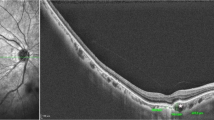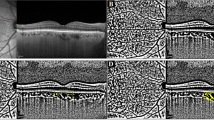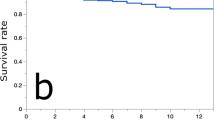Abstract
Purpose
To describe and correlate the morphological and clinical features of focal choroidal excavation (FCE).
Methods
This is a consecutive case series from the review of the 4436 optical coherence tomography scans performed by Kowloon East Cluster Ophthalmic Service from 1 August 2014–31 January 2016. Statistical analysis was performed on SPSS 18.0 (SPSS, Chicago, IL, USA). A significance level of P<0.05 was taken.
Results
All 16 patients with FCE had unilateral involvement. The mean age of diagnosis was 52.56±14.00. The mean greatest linear dimension (GLD) of FCE was 636.25±265.11 μm. The mean choroidal thickness was 183.63±52.39 μm. Fourteen FCEs (87.5%) were conforming and two were non-conforming (12.5%). In the eyes with FCE, concurrent macular pathology was present in four cases (25.0%). Tractional pathologies of macular pucker and macular scar corresponded to the two non-conforming FCEs in the series. Polypoidal choroidal vasculopathy (PCV) and lacquer crack had a close topographic relationship with the FCE. The mean GLD was significantly larger in eyes with concurrent macular pathology than those without (878.00 vs 555.67 μm, P=0.029). In the fellow eyes, concurrent macular pathology was present in 5 cases (31.3%): PCV in 3 cases and chronic central serous chorioretinopathy in 2 cases.
Conclusion
As a significant proportion of FCE is associated with concurrent macular pathology in the involved or fellow eye, angiography for both eyes is recommended even for asymptomatic cases. The GLD of FCE may have clinical value in risk stratification.
Similar content being viewed by others
Log in or create a free account to read this content
Gain free access to this article, as well as selected content from this journal and more on nature.com
or
References
Jampol LM, Shankle J, Schoroeder R, Tornambe P, Spaide RF, Hee MR et al. Diagnostic and therapeutic challenges. Retina 2006; 26 (9): 1072–1076.
Margolis R, Mukkamala SK, Jampol LM, Spaide RF, Ober MD, Sorenson JA et al. The expanded spectrum of focal choroidal excavation. Arch Ophthalmol 2011; 129 (10): 1320–1325.
Hashimoto Y, Saito W, Noda K, Ishida S . Acquired focal choroidal excavation associated with multiple evanescent white dot syndrome: observations at onset and a pathogenic hypothesis. BMC Ophthalmol 2014; 14: 135.
Wakabayashi Y, Nishimura A, Higashide T, Ijiri S, Sugiyama K . Unilateral choroidal excavation in the macula detected by spectral-domain optical coherence tomography. Acta Ophthalmol 2010; 88 (3): e87–e91.
Lee J, Lee W . Choroidal neovascularization associated with focal choroidal neovascularization. Am J Ophthalmol 2014; 157: 710–718.e1.
Obata R, Takahashi H, Ueta T, Yuda K, Kure K, Yanagi Y . Tomographic and angiographic characteristics of eyes with macular focal choroidal excavation. Retina 2013; 33: 1201–1210.
Kobayashi W, Abe T, Tamai H, Nakazawa T . Choroidal excavation with polypoidal choroidal vasculopathy: a case report. Clin Ophthalmol 2012; 6: 1373–1376.
Ellabban AA, Tsujikawa A, Ooto S, Yamashiro K, Oishi A, Nakata I et al. Focal choroidal excavation in eyes with central serous chorioretinopathy. Am J Ophthalmol 2013; 156: 673–683.
Suzuki M, Gomi F, Hara C, Sawa M, Nishida K . Characteristics of central serous chorioretinopathy complicated by focal choroidal excavation. Retina 2014; 34: 1216–1222.
Luk FO, Fok AC, Lee A, Liu AT, Lai TY . Focal choroidal excavation in patients with central serous chorioretinopathy. Eye 2015; 29 (4): 453–459.
Lee CS, Woo SJ, Kim YK, Hwang DJ, Kang HM, Kim H et al. Clinical and spectral-domain optical coherence tomography findings in patients with focal choroidal excavation. Ophthalmology 2014; 121: 1029–1035.
Guo J, Zhong L, Jiang C, Zhou X, Xu G, Wang W et al. Clinical and optic coherence tomography findings of focal choroidal excavation in Chinese patients. BMC Ophthalmol 2014; 14: 63.
Shinojima A, Kawamura A, Mori R, Yuzawa M . Morphologic features of focal choroidal excavation on spectral domain optical coherence tomography with simultaneous angiography. Retina 2014; 34: 1407–1414.
Xu H, Zeng F, Shi D, Sun X, Chen X, Bai Y . Focal choroidal excavation complicated by choroidal neovascularization. Ophthalmology 2014; 121: 246–50.
Lim FP, Loh BK, Cheung CM, Lim LS, Chan CM, Wong DW . Evaluation of focal choroidal excavation in the macula using swept source optical coherence tomography. Eye 2014; 28: 1088–1094.
Kuroda Y, Tsujikawa A, Ooto S, Yamashiro K, Oishi A, Nakanishi H et al. Association of focal choroidal excavation with age related macular degeneration. Invest Ophthalmol Vis Sci 2014; 55: 6046–6054.
Cheung CM, Bhargava M, Laude A, Koh ACh, Xiang L, Wong D et al. Asian age-related macular degeneration phenotyping study: rationale, design and protocol of a prospective cohort study. Clin Exp Ophthalmol 2012; 40: 727–735.
Acknowledgements
Special thanks to Mr Raymond M Wu for all the OCT images of this manuscript.
Author information
Authors and Affiliations
Corresponding author
Ethics declarations
Competing interests
The authors declare no conflict of interest.
Additional information
Part of the contents of the manuscript was presented in the Hong Kong Ophthalmological Symposium in November, 2016.
Rights and permissions
About this article
Cite this article
Chung, C., Li, S. & Li, K. Focal choroidal excavation—morphological features and clinical correlation. Eye 31, 1373–1379 (2017). https://doi.org/10.1038/eye.2017.71
Received:
Accepted:
Published:
Issue date:
DOI: https://doi.org/10.1038/eye.2017.71
This article is cited by
-
Analysis of clinical features and SS-OCT findings in patients with focal choroidal excavation
Scientific Reports (2025)
-
Long-term follow-up demonstrates change in conformation shape of the focal choroidal excavation lesions
BMC Ophthalmology (2024)
-
Visual functions and multimodal imaging of patients with idiopathic focal choroidal excavation
Scientific Reports (2024)
-
Pathophysiology of central serous chorioretinopathy: a literature review with quality assessment
Eye (2022)
-
Intercalary membrane break and detachment causes intrachoroidal cavitation in macular coloboma
International Ophthalmology (2022)



